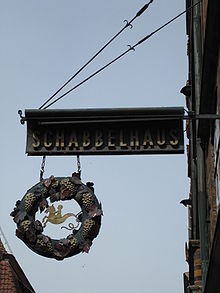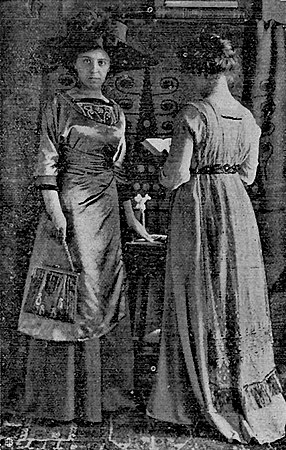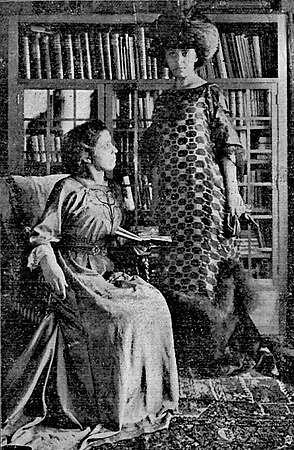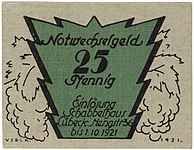Schabbelhaus (Lübeck)

The Schabbelhaus in Lübeck's Mengstraße are two town houses of the brick renaissance below the Buddenbrookhaus on the banks of the Trave , in a part of the street that was not affected by the bombing in March 1942 . The Schabbelhaus is named after the donating master baker Schabbel; the Schabbellhaus in Wismar has a different background.
present
It is representatively furnished in the style of the end of the 18th century and thus actually at the same time a museum for upscale bourgeois Hanseatic living culture. It belongs to the Lübeck merchants who use it twice a year for members' meetings and otherwise operate it as a restaurant. The courtyard garden was originally designed by Harry Maasz in the mid-20th century .
The representative portal of the house at Mengstrasse 50 comes from the former home of the Lübeck merchant Johann Glandorp on Fischstrasse and was moved here because the house at the original location had otherwise been completely destroyed.
Previous construction
history
The baker and confectioner Heinrich Schabbel , born on July 24th 1861 - his great-grandfather Joachim Christian Schabbel came to Lübeck as a free baker from Malchin around 1778 - donated 125,000 gold marks to the city in his will for a foundation . The baker's wealth was based on his invention of the Hanseatic . The aim was to establish a museum that preserved and documented Lübeck town houses and their facilities from the late 17th to the middle of the 19th century. After Schabbel's death on December 12, 1904, the city decided to acquire a largely originally preserved merchant's house at Mengstrasse 36. A fire shortly before the contract was signed destroyed the upper storey floors of the front building, but the lower floors remained intact. The Renaissance building has now been restored and the furniture has been supplemented with pieces from other town houses and churches. The museum was opened in September 1908. A popular wine tavern opened on the ground floor.
On Palm Sunday 1942, British incendiary bombs destroyed the houses on Mengstrasse. The original Schabbelhaus was not rebuilt, instead the museum and wine tavern moved to the semi-detached house Mengstraße 48/50.
Architecture and equipment
The building must have been redesigned in the baroque period, as indicated by the curved facade gable. The sandstone portal to Mengstraße came from the Renaissance (around 1590), the carved entrance door with skylight from the Rococo . The hall with a double staircase reached over two floors, and high three-part windows opened onto the inner courtyard. The oldest part of this anteroom was formed by wood paneling dated 1595 with an embedded Rococo wall cupboard. The rest of the furnishings, such as the kitchen installation in the hallway with the servants' room above or the richly furnished landscape room, came from the 18th century.
Lübeck Art Friends Association
The steadily growing association founded in 1904 celebrated its foundation festival here every year. On March 14, 1909, the association opened the exhibition From old chests in the Schabbelhaus and, looking back on its five-year existence, celebrated its first foundation festival . By then, the small founding group had grown to a large group .
At the festival in 1911, the wish to see the new women's costume , to which the notebooks in the green folder often pointed, demonstrated by its inventor, Hedwig Buschmann (1872–1950), was taken into account.
After first demonstrating the old Lübeck costumes , as it was called in the song Fidel bi Drög un Ratt , the latest costumes ( reform clothing ) were presented in colored photographs and later the 30 or so dresses as shown below, supported by society women.
- 1911 fashion show
The basic shape in the simple shirt cut with trimmed sleeves , the simplest closure, and complete authenticity delighted . The fabric was no longer cut into patchwork , the color of the fabric appeared stronger over large areas, jewelry and embroidery appeared both purer and more elegant on the undivided ground. As further advantages the ease of manufacture, the comfortable were flattening the wash clothes and lightweight packaging - everything is already before the hall was evacuated by the last visitors in the mid-size suitcases packed - was convincing the surprised women demonstrated . As Buschmann emphasized earlier, this new women's costume should be of the greatest benefit.
The Schabbelhaus in art
The Museum of Modern Art has a menu of the Schabbelhaus that has been alienated from the Dadaist Kurt Schwitters as a guest of the house.
Emergency money
Friedrich Wilhelm Virck designed emergency money for the Schabbelhaus in 1920 and 1921 , which were only valid in the restaurant.
- Emergency money
literature
- Johannes Baltzer : The Schabbelhaus in Lübeck. In: The preservation of monuments. Volume 12, No. 3, March 2, 1910, pp. 17-20 and No. 4, March 30, 1910, pp. 25-27.
supporting documents
- ^ A b Edgard Haider: Lost splendor. Stories of destroyed buildings. Gerstenberg Verlag, Hildesheim 2006, p. 14 ff.
- ↑ Das Schabbelhaus zu Lübeck (luebeck.de) accessed on October 6, 2012.
- ↑ New women's costumes. In: Patriotic papers . Year 1911, No. 24, edition of March 12, 1911, pp. 42–43.
- ^ Heinz Röhl, Jan Romanowski: Lübeck's paper money in the 19th and 20th centuries . Schmidt-Römhild, Lübeck 2011, ISBN 978-3-7950-5201-0 , pp. 138, 179 .
Web links
Coordinates: 53 ° 52 ′ 8 ″ N , 10 ° 40 ′ 54 ″ E








